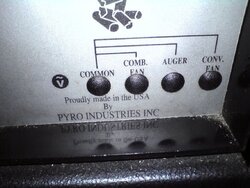A pellet stove is so simple in concept and design (should be)
The manufactire have taken these things way too far into the arena of electronics wizardry.
Here is a link to a company that sells solid state industrial controls .
http://www.precisiontimer.com/index.html
I have spent many hours siting and designing a new controller for my Whitfield.
Two relay timers are needed to operate the stove.
A "One shot" timer that operates to send power around the low temp switch during startup and the adustable on/off timer to control the time that the feed motor is on and off.
The whitfields can run happily with a feed time of about 1.5 to 2 seconds on and then lock that setting (relay available with that setting accessable by screwdriver only) and the off time (burn time) adjustble from .1 to 10 seconds with a knob
These are either 8 pin or 11 pin industrial type units that plug into a standard architecture relay base plug.
The original high temp/low temp safeties as well as the pressure switch are retained.
The draft/exhaust fan are run directly off the master switch so the exhaust runs anytime the stove master switch is ON.
The room air blower is connected to a rheostat and the rest is real basic.
The only extra I recommend is a a snap switch that will turn the room blower on high if someone forgets to turn the blower on and set it according to the heat setting.
(many older earthstoves had this feature and it was nice that you could leave the fans off until there was some heat in the unit)
If the stove reaches a predetermined high temp then the fan comes on anyway
This setup gives the operator complete adustment of the feed rates and the fans.
The exhaust fan can run full speed and if there needs to be any change in air flow to the fire it can be done with the damper.
These controls are readily available and can be swapped out quickly in the event of a failure.
The composit "Factory" boards for these older stove left a lot to be desired, especially when it came to reliability
I have marked the 636 PL5 and the one shot 634 G5K
Manufactures want to have propietary parts and that is understandable BUTTTTT when the stuff is flakey and many of the older boards were then one has to come up with better things.
WARNING
If you decide to wire up a controler, keep in mind that you MUST wire in all the original overtemp and undertemp safety snap switches and the pressure switch.
Failure to do this can place you, your home and others in danger.
The industrial controls are head and shoulders above the stock stuff in quality.
If you get a failure in one of these relays, its a matter of simply plugging in a fresh one.
Maybe all of a couple minutes depending on how you build your controller.
I like off the shelf technology that I can buy.
Once I get a controler into the size package that I can fit into the control panel opening on the Advantage II I will snap some pix and post them.
Currently my build is sitting on a piece of plastic project board with wires snaking around here and there and then off to the stove.
Just a matter of situating all the components onto a nice little panel and fitting it into the opening in the stove.
Best
Snowy



